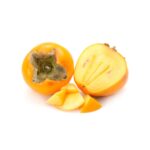An easy trick to peel grapes using just a toothpick. (Source: @nutrinnature)
Grapes are loved by many for their delicious taste and nutritional benefits. However, peeling grapes can be a hassle due to their small size and slippery skin. Fret not, as this handy trick using just a toothpick will make grape peeling a breeze.
How to Peel Grapes with a Toothpick
First, thoroughly rinse the grapes under running water to remove any dirt or chemicals. Either let them air dry or gently pat them dry with a paper towel. Then, carefully separate each grape from the bunch. This makes it easier to work with them when peeling.
Using a sharp toothpick, make a longitudinal incision from the stem to the bottom of the grape. Then, make another incision at a 45-degree angle, also starting from the stem and ending at the bottom. Gently peel off the skin from the intersection of the two incisions, and voilà—your grape is peeled!

Make a longitudinal incision with the toothpick. (Screenshot)

Peel the skin from the intersection of the two incisions. (Screenshot)
If the skin doesn’t come off easily on the first try, patiently rotate the grape and attempt it from different angles.
Once peeled, you can enjoy the grapes as they are or use them in various recipes such as salads, juices, or as decorations on cakes.
Benefits of Peeling Grapes with a Toothpick
This method requires nothing more than a simple toothpick, making it accessible and easy for anyone to execute.
Unlike other grape-peeling techniques that might bruise the fruit, using a toothpick helps maintain the grape’s shape and juiciness.
Additionally, this trick allows you to peel a large quantity of grapes in a short amount of time, which is especially useful when preparing fruit for parties or events.
Tips for Choosing Fresh Grapes
Selecting tasty, fresh, and safe grapes isn’t always easy. Here are some expert-recommended tips to help you choose the best grapes:
Observe the Appearance
When buying grapes, look for bunches with uniform coloring. For green grapes, go for a light emerald green; for red and black grapes, choose deep, rich colors. This indicates that the grapes are ripe and full of flavor.
Select grapes with taut, shiny skins. Avoid grapes with wrinkled surfaces, as this indicates dehydration and a loss of freshness.

Choosing fresh grapes depends on various factors. (Image: Food Network)
Test for Firmness
The perfect grape should have a certain firmness to it—not too soft, not too hard. Gently squeeze each grape, and if it feels just right, it’s a good indication of quality.
Natural Aroma
Fresh grapes often have a sweet, natural fragrance. Steer clear of bunches with strong or unusual odors, as this could be a sign of chemical preservatives.
Check the Stems
Fresh grape stems are green and flexible. If the stems are dry and brittle, it’s likely that the grapes have been harvested and stored for a while, compromising their quality.
Consider the Origin
Opt for grapes with a clear origin, preferably organic or sourced from reputable farms that ensure food safety.
According to VTCnews
8 Delicious and Nutritious Fruits That Are Easy to Find in October
In October, an array of delectable fruits come into season, offering a delightful cornucopia of flavors to savor. From the crisp, juicy pears to the vibrant, fragrant pinks, and the tangy, refreshing grapefruit, with the ever-popular bananas also in abundance, there’s a veritable feast of autumnal delights to indulge in.
Fresh and Dried Grapes: Which is the Superior Snack?
Nho is a popular fruit in Vietnam, with both fresh and dried varieties enjoyed by families across the country. But which type is healthier for you and your family? That’s the question we’re here to answer. With its unique health benefits and delicious taste, nho and its derivatives have become a specialty of Ninh Thuan province. So, whether you’re snacking on fresh grapes or adding dried ones to your yogurt, you’re in for a treat!






































